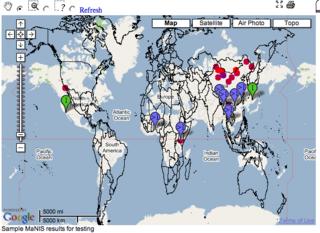
The screenshot to the left illustrates what happens when layering country boundaries from a WMS using a geographic projection on top of GoogleMaps. The interesting thing is that if we were to zoom in on a particular portion of the world, the boundaries would line up. This is why many people are able to use a geographic projection with Google Maps if only using for large-scale mapping projects.
OK, so what if we wanted to utilize a Mercator Projection from a WMS service on top of GoogleMaps? Here is how I did it, using Mapserver and Proj4 for the WMS content (details at the mapserver website):
1. Add the appropriate Mercator definition in the Proj4 EPSG file:
# Mercator
<54004> +proj=merc +lat_ts=0 +lon_0=0 +k=1.000000 +x_0=0 +y_0=0 +ellps=WGS84 +datum=WGS84 +units=m no_defs <>
2. Alter the Mapserver Map File so the Output Projection looks like:
PROJECTION
"init=epsg:54004"
END
3. Add the epsg:54004 projection definition to the WEB section of the Mapfile like:
WEB
METADATA
"wms_srs" "EPSG:4326 EPSG:54004"
.....
4. Make sure that the layers in the mapfile reflect their native projection.
5. Alter the Javascript in the GMaps_WMSSpec_0.1.js code (references to the source of this code appear in an earlier post). Primarily, I added two functions to convert decimal degrees to Mercator Meters so the GoogleMaps API can call the WMS service in a language it can understand:
// dd2MercMeters Conversion Functions
// from http://search.cpan.org/src/RRWO/GPS-Lowrance-0.31/lib/Geo/Coordinates/MercatorMeters.pm
//
var MAGIC_NUMBER=6356752.3142;
var DEG2RAD=0.0174532922519943;
var PI=3.14159267;
function dd2MercMetersLng(p_lng) {
return MAGIC_NUMBER*(p_lng*DEG2RAD);
}
function dd2MercMetersLat(p_lat) {
if (p_lat >= 85) p_lat=85;
if (p_lat <= -85) p_lat=-85;
return MAGIC_NUMBER*Math.log(Math.tan(((p_lat*DEG2RAD)+(PI/2)) /2));
}
6. Make a couple of alterations in the WMSSpec.prototype.getWMSURL function. Attached here is the whole function as I code it:
WMSSpec.prototype.getWMSURL=function(a,b,c, url, layers, format) {
if (!this.Styles) this.Styles="default";
var ts = this.tileSize;
var ul = this.getLatLng(a*ts,(b+1)*ts, c);
var lr = this.getLatLng((a+1)*ts, b*ts, c);
// user mercator for small scale
if (map.getZoomLevel() > 12) {
var bbox = dd2MercMetersLng(ul.x) + "," + dd2MercMetersLat(ul.y) + "," + dd2MercMetersLng(lr.x)+ "," + dd2MercMetersLat(lr.y);
var l_strSRS="SRS=EPSG:54004";
} else {
var bbox = ul.x + "," + ul.y + "," + lr.x + "," + lr.y;
var l_strSRS="SRS=EPSG:4326";
}
var url = url + "REQUEST=GetMap&SERVICE=WMS&VERSION=1.1.1&LAYERS=" + layers + "&STYLES=" + this.Styles + "&FORMAT=" + format + "&BGCOLOR=0xFFFFFF&TRANSPARENT=TRUE&"+l_strSRS+"&BBOX=" + bbox + "&WIDTH=" + ts + "&HEIGHT=" + ;
this.cURL=url;
return url;
}
You'll notice in step #6 above that I don't use Mercator for resolutions below 13. This is because I believe the nifty little javascript re-project is not quite as accurate as it can be (hey-- what do you expect from javascript doing reprojections!). Anyway, reverting to latlong at lower zoom levels will fix this.
Thats it! The resulting map will looksomething like the screenshot below. The lines going across the top of the Russian Federation, by the way, I think are an artifact of drawing country boundaries across the international dateline. Since I'm only using point data for my real application i didn't worry about this. Not sure if this is an issue but I think it crept in because my source data is stored in geographic units.
